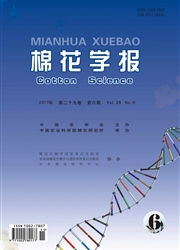

 中文摘要:
中文摘要:
以转基因抗虫棉品种农大棉9号(ND9)和国欣棉3号(GX3)为材料,设4个镉(Cd)处理(0μmol·L-1、25μmol·L-1、50μmol·L-1、100μmol·L-1)。结果表明:随Cd处理浓度升高,棉苗干物质质量、根系总根长、总表面积和总体积呈下降趋势;根冠比和根系直径呈升高趋势。Cd在根、茎、叶中的积累量表现为(叶片+叶柄)〉根系〉茎。当Cd处理浓度为50μmol·L-1时的转移率(TF)达到最大,为对照的2.2倍;处理浓度为100μmol·L-1时,TF则呈下降趋势。表明Cd胁迫增加棉苗体内Cd积累量,根系生长受到抑制,阻碍地上部植株发育,最终对棉苗产生毒害作用。
 英文摘要:
英文摘要:
Using transgenic cotton varieties Nongda 9 and Guoxin 3 as study materials, four different cadmium(Cd) concentrations were designed to investigate the effects of Cd on growth effect and Cd accumulation in cotton seedlings. With increasing Cd concentrations, the dry matter accumulation, total root length, total surface area, and total volume of cotton seedlings decreased significantly, while the root/shoot ratio and root diameter increased. Cd accumulation showed that: (blade + petiole) 〉 root 〉 stem. Moreover, translocation factors in 50 μmol·L^-1 Cd treatment peaked at 2,2 times the control level, and declined at 100 μmol·L^-1 Cd. These experiments showed that Cd stress increased Cd accumulation, inhibited root growth, and hindered above-ground plant growth, resulting in a toxic effect on cotton seedlings.
 同期刊论文项目
同期刊论文项目
 同项目期刊论文
同项目期刊论文
 期刊信息
期刊信息
